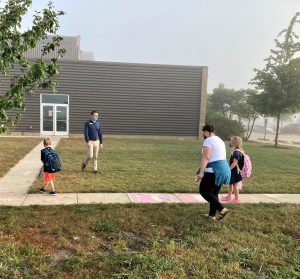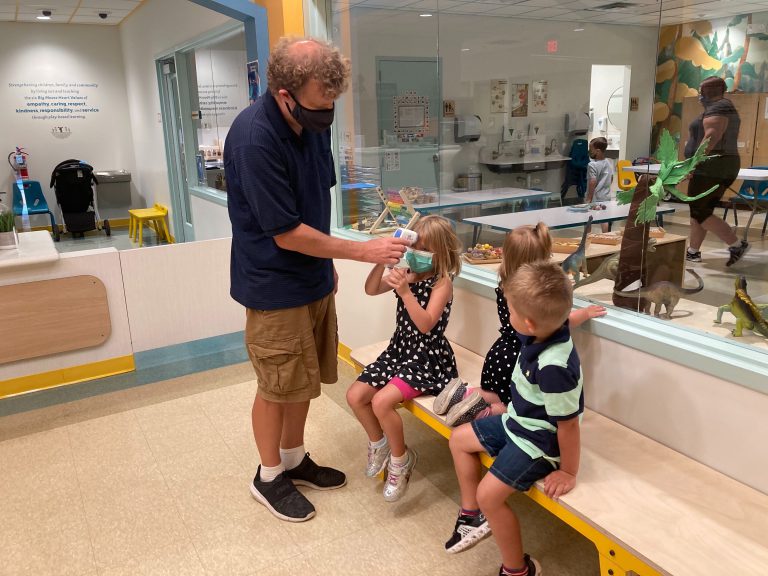Sierra is in a bind. She and her husband have two children — ages three and nine years old — and they live in Urbana.
Sierra’s 9-year-old son is attending school remotely this fall, because the local school district has deemed it unsafe to reopen for in-person instruction. While she and her husband placed their toddler in daycare, they haven’t found a spot for their son.
Sierra works full-time at an assisted living facility, and her husband works on trains.
“The places that are just like smaller-run facilities or just home centers, they’re filled because they aren’t set up to take all these school-aged kids,” Sierra says. “And then the places that aren’t filled, they’re outrageously expensive. I mean, they’re more than our rent and our car payment combined.”
With some school districts operating remotely, parents like Sierra are scrambling to find childcare. Childcare centers are trying to meet the demand while also operating as safely as possible during the COVID-19 pandemic.
The Stephens Family YMCA in Champaign County created the “Y Academy” to serve families who need childcare during the school and work day. Jeff Dobrik, chief operating officer for the Champaign YMCA, says they’re currently caring for about 50 children at multiple locations.
“The vast majority of the kids are elementary school age. But we do have a group of fifth graders and up,” Dobrik says.
To mitigate the risk of transmission, Dobrik says the Y keeps students in small groups of 10 or fewer, with two staff members assigned to each cohort. When children arrive for the day, staff at the Y take their temperature with an infrared thermometer, and they’re escorted by staff into the building where they immediately wash or sanitize their hands, Dobrik says.

Children and staff wear masks inside the building, and he says they maintain six feet of distance between individuals as much as possible.
“When they’re seated within their work stations, they do a great job, and then some of that free time, that’s when we just have to remind them a little bit,” Dobrik says. “It’s always a constant reminder regarding masks, spacing, all those types of things.”
Imani Harrison sends her seven-year-old son, Mylan, to the Y Academy. His school district has opted to teach students remotely for the time being. She says she and her husband both work, which means they need childcare during the school day. Harrison says she can manage the cost of childcare, but it was an unexpected expense.
“It’s like having two kids in daycare now. But we were in a position to be able to do that this year, and so we’re super grateful for that. But, yeah, if we weren’t, I don’t know what we would do,” Harrison says.
Dobrik says childcare at the YMCA costs between $130 and $150 per child, per week. He says scholarships are available, and childcare subsidies are accepted.
Harrison acknowledges there are risks involved sending her children to a childcare provider during a pandemic. But, she’s satisfied with the mitigation measures the Y Academy has employed.
Janelle and Jeremy Sander send their three children — ages five, three and one — to the Lodgic Kids Camp in Champaign. Their five-year-old is attending kindergarten remotely. Janelle Sander says they were initially hesitant to send their children to childcare, but opted to do so about a month after the Lodgic Kids Camp reopened earlier this year.
“I wanted to see kind of how it was going,” Janelle Sander says. “And the things that make me feel comfortable that they do is the temperature check everyday. They have hand sanitizer everywhere. They’re always in contact with us about anything that happens during the day.”
Jasmine Carroll, director of the program, says the camp serves children from age one to 12.
She says the program has reduced its child to staff ratio — now one staff member to four infants, a maximum of 12 children in their preschool room, and a one to 15 staff to child ratio for older children.
Carroll says Lodgic is no longer providing childcare by the hour. Instead, she says, parents must provide a set schedule for drop off and pick up times a week in advance. She says staff also sanitize high-touch surfaces every 30 minutes.
Lodgic charges $255 per week per school-aged child, and $305 per week per child ages one to five for full-time care. Part-time passes, which cover 25 hours, cost about $200 per week for all ages.
The Sander family can afford the cost partly because they didn’t pay for childcare for three months in the spring.
“It does impact us,” says Janelle Sander, who works full-time. “But we are grateful that we do have the childcare option.”
Health experts say there are key differences between the way schools and childcare centers operate, which mean that the latter can mitigate the risk of COVID-19 transmission more easily.
Mark Schleiss, a professor of pediatrics at the University of Minnesota’s medical school, says childcare centers can limit the amount of exposure each child has by keeping them contained in small groups that do not interact with each other.
“One model that has emerged from some recommendations is to allow small childcare groupings, one provider per nine or 10 children. That is quite different than what we see in some crowded public classrooms where there may be 30, 40 or even more students in a classroom,” he says.
If you keep classmates constant, with the same supervisor in each room, and use social distancing and masking, “there are going to be at least fewer exposures overall,” Schleiss says.
Still, there are other health risks to consider, especially for parents like Sierra, who says she might need to leave her job to care for her son because she can’t afford childcare. (She asked us not to use her last name because she doesn’t want her employer to know she may be forced to quit).
“And I don’t know what we’re gonna do. This should not be the reason that I leave this (job) and come back home. To do what? How is that in the best interest of anyone?” Sierra says.
New research from the U.S. Census Bureau and Federal Reserve show Sierra isn’t alone: About one in five adults say they aren’t working because COVID-19 has disrupted their childcare arrangements.
Elliot Haspel, an education policy expert and the author of “Crawling Behind: America’s Child Care Crisis and How to Fix It,” says loss of family income can have negative long-term health effects on children and parents.
“It’s bad for the health of parents and it’s bad for the health of kids,” Haspel says. “We know that income stability and family stability has an intrinsic connection to child development and child well-being. So we’re really putting the screws to families in ways that are unconscionable.”
Haspel says the solution isn’t just small groups, social distancing and masking in childcare centers — it’s also providing affordable care.
Sierra says she doesn’t blame schools for teaching remotely. She understands the risks of COVID-19 because she contracted the virus earlier this year. Still, she wishes there were more support offered for families in her situation.
“If I’m an essential worker, it’s essential that my kids have somewhere to go. It’s essential that my kids are safe. It’s essential that my kids get an education,” Sierra says. “I can’t do my work without a little help here.”
Follow Lee Gaines on Twitter: @LeeVGaines
Lee Gaines is a reporter for Illinois Public Media.

